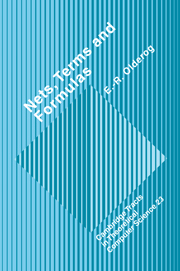
-
Select format
-
- Publisher:
- Cambridge University Press
- Publication date:
- January 2010
- October 1991
- ISBN:
- 9780511526589
- 9780521400442
- 9780521018456
- Dimensions:
- (247 x 174 mm)
- Weight & Pages:
- 0.67kg, 278 Pages
- Dimensions:
- (247 x 174 mm)
- Weight & Pages:
- 0.446kg, 280 Pages
You may already have access via personal or institutional login
Book description
The author presents a theory of concurrent processes where three different semantic description methods that are usually studied in isolation are brought together. Petri nets describe processes as concurrent and interacting machines; algebraic process terms describe processes as abstract concurrent processes; and logical formulas specify the intended communication behaviour of processes. At the heart of this theory are two sets of transformation rules for the top-down design of concurrent processes. The first set can be used to transform stepwise logical formulas into process terms, whilst process terms can be transformed into Petri nets by the second set. These rules are based on novel techniques for the operational and denotational semantics of concurrent processes. Various results and relationships between nets, terms and formulas starting with formulas and illustrated by examples. The use of transformations is demonstrated in a series of case studies, and the author also identifies directions for research.
Reviews
"The unique feature of this book is that it unifies different views of concurrency rather than adding another view. The author does so in a clear and convincing fashion....requires the reader to be fluent in such mathematical concepts as sets, relations, functions, and predicate logic, and to be familiar with the basic concepts of automata and regular languages. Readers who enjoy the mathematical maturity will find the book excellent: it is carefully written, and the material is presented in a well-chosen order and at the right level of detail. The author must be a good teacher." Martin Rem, Computing Reviews
Contents
Metrics
Full text views
Full text views help Loading metrics...
Loading metrics...
* Views captured on Cambridge Core between #date#. This data will be updated every 24 hours.
Usage data cannot currently be displayed.
Accessibility standard: Unknown
Why this information is here
This section outlines the accessibility features of this content - including support for screen readers, full keyboard navigation and high-contrast display options. This may not be relevant for you.
Accessibility Information
Accessibility compliance for the PDF of this book is currently unknown and may be updated in the future.


